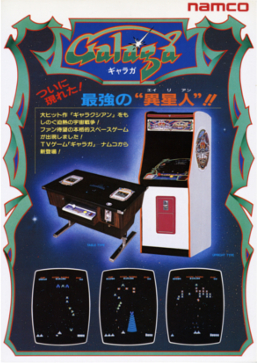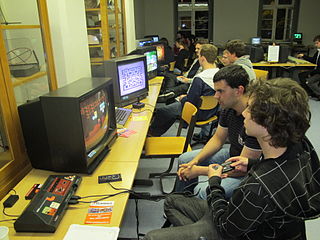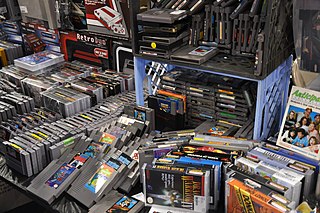
Pac-Man, originally called Puck Man in Japan, is a 1980 maze action video game developed and released by Namco for arcades. In North America, the game was released by Midway Manufacturing as part of its licensing agreement with Namco America. The player controls Pac-Man, who must eat all the dots inside an enclosed maze while avoiding four colored ghosts. Eating large flashing dots called "Power Pellets" causes the ghosts to temporarily turn blue, allowing Pac-Man to eat them for bonus points.

Super Mario 64 is a 1996 platform game developed and published by Nintendo for the Nintendo 64. It was released in Japan and North America in 1996 and PAL regions in 1997. It is the first Super Mario game to feature 3D gameplay, combining traditional Super Mario gameplay, visual style, and characters in a large open world. In the game, Bowser, the primary antagonist of the Super Mario franchise, invades Princess Peach's castle and hides the castle's sources of protection, the Power Stars, in many different worlds inside magical paintings. As Mario, the player collects Power Stars to unlock enough of Princess Peach's castle to get to Bowser and rescue Princess Peach.

Super Mario Bros. 2 is a platform game developed and published by Nintendo for the Nintendo Entertainment System. It was first released in North America in September 1988, and in the PAL region in 1989.

Atari Games Corporation, known as Midway Games West Inc. after 1999, was an American producer of arcade games. It was formed in 1985 when the coin-operated arcade video game division of Atari, Inc. was transferred by Warner Communications to a joint venture with Namco. It was one of several successor companies to use the name Atari. The company developed and published games for arcades and across consumer gaming consoles such as the Commodore 16, Commodore 64, Game Boy, Nintendo Entertainment System (NES) and other platforms using the Tengen label. Some of the games Atari had developed include Tetris, Road Runner, RoadBlasters and Primal Rage. After Time Warner reassumed full ownership in 1994, the company was sold to WMS Industries in 1996, and became part of Midway Games when that company was spun-off by WMS in 1998. It ceased operations in 2003 and its former assets were sold back to Warner Bros. Interactive Entertainment in 2009 following Midway's bankruptcy.

In the history of video games, the third generation of video game consoles, commonly referred to as the 8-bit era, began on July 15, 1983, with the Japanese release of two systems: Nintendo's Family Computer and Sega's SG-1000. When the Famicom was released outside of Japan, it was remodeled and marketed as the Nintendo Entertainment System (NES). This generation marked the end of the video game crash of 1983, and a shift in the dominance of home video game manufacturers from the United States to Japan. Handheld consoles were not a major part of this generation; the Game & Watch line from Nintendo and the Milton Bradley Microvision that were sold at the time are both considered part of the previous generation due to hardware typical of the second generation.

Galaga is a 1981 fixed shooter arcade video game developed and published by Namco. In North America, it was released by Midway Manufacturing. It is the sequel to Galaxian (1979), Namco's first major video game hit in arcades. Controlling a starship, the player is tasked with destroying the Galaga forces in each stage while avoiding enemies and projectiles. Some enemies can capture a player's ship via a tractor beam, which can be rescued to transform the player into a "dual fighter" with additional firepower.

Masayuki Uemura was a Japanese engineer, video game producer, and professor. He was known for his work as an employee of Nintendo from 1971 to 2004, most notably for serving as a key factor in the development of the Nintendo Entertainment System.

Dig Dug is a maze arcade video game developed by Namco in 1981 and released in 1982, distributed in North America by Atari, Inc. The player controls Dig Dug to defeat all enemies per stage, by either inflating them to bursting or crushing them underneath rocks.

Retrogaming, also known as classic gaming and old school gaming, is the playing and collection of obsolete personal computers, consoles, and video games. Usually, retrogaming is based upon systems that are outmoded or discontinued, although ported retrogaming allows games to be played on modern hardware via ports or compilations. It is typically for nostalgia, preservation, or authenticity. A new game could be retro styled, such as an RPG with turn-based combat and pixel art in isometric camera perspective.

The Sheffield Co-operative Society was a local consumer co-operative trading in Sheffield, South Yorkshire, England.
GameCity is an independent organisation based in Nottingham, UK, which has worked since 2006 with the support of Nottingham Trent University to bring videogames to the widest possible audiences. This has been done through an annual GameCity Festival, described as the "Sundance of the video games world", the GameCity Prize since 2011, and the National Videogame Arcade since 2015. Each year, GameCity hosts talks and presentations from individuals and companies working in the games industry.

Kentucky Route Zero is a 2020 point-and-click adventure interactive fiction game developed by Cardboard Computer and published by Annapurna Interactive. The game follows the narrative of a truck driver named Conway and the strange people he meets as he tries to cross the mysterious Route Zero in Kentucky to make a final delivery for the antiques company for which he works. The game received acclaim for its visual art, narrative, characterization, atmosphere and themes, appearing on several best-of-the-decade lists.

Gamer Network Limited is a British digital media company based in Brighton. Founded in 1999 by Rupert and Nick Loman, it owns brands—primarily editorial websites—relating to video game journalism and other video game businesses. Its flagship website, Eurogamer, was launched alongside the company. It began hosting video game trade show EGX in 2008. In 2018, it was acquired by ReedPop, a division of RELX.
MXGP The Official Motocross Videogame was the first in a series of racing video games developed and published by Milestone. The game was released worldwide on 18 November 2014 for Microsoft Windows, PlayStation 3, PlayStation 4, PlayStation Vita and Xbox 360.

Video game preservation is a form of preservation applied to the video game industry that includes, but is not limited to, digital preservation. Such preservation efforts include archiving development source code and art assets, digital copies of video games, emulation of video game hardware, maintenance and preservation of specialized video game hardware such as arcade games and video game consoles, and digitization of print video game magazines and books prior to the Digital Revolution.













